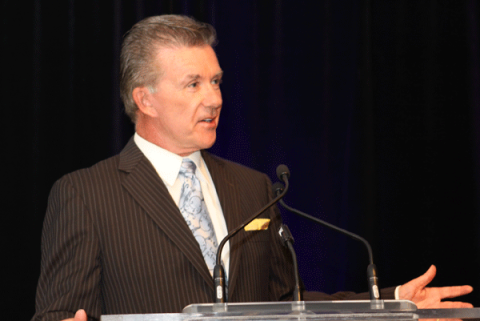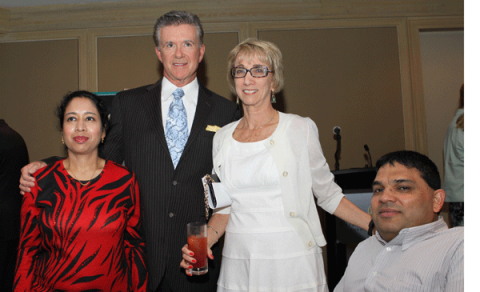
Thicke spoke with Samaritanmag in Toronto the day of his speech at the March of Dimes’ Ability & Beyond Gala Dinner recently and in a short 15-minute interview raised some important points about diabetes research to care-giving.
Did volunteering for you begin in your youth?
I was actually involved as a teenager in organized religion, to the point that I was — some of that is considered to be socially conscious and charitable — to the point where I was threatening to become a minister in the United Church of Canada, and began in an ecumenical college at the University of Western Ontario [in London, Ont.]. I think I didn’t feel I would ever be a good enough person to really follow through with that.
Well part of that [religion and being a minister] is volunteering, right?
There was volunteerism and volunteerism at the college level when I was there. I was probably a good enough person to be a volunteer, but not good enough to be a minister in charge of the flock doing that.
Right, and did it ultimately stay with you as you pursued acting? Because acting is the type of thing where you have to be single-minded and focused to get to a level where you’re making money and making a living — you don’t really have time to be volunteering.
I probably did my part. I did my fair share. I wasn’t a crusader for anything until my son was diagnosed with diabetes. At that point, your eyes open up; you’ll go crazy if you don’t do something and feel that you’re being proactive in some way.
Which son is that?
My eldest son, Brennan (now 38). And so I started by joining every diabetes organization in the world — every national organization — and some few fundraisers, and even started some chapters for JDRF, Juvenile Diabetes Research Fund; they didn’t have chapters at the time, for instance, in cities like Ottawa [and] Calgary. Los Angeles had a chapter with a little office desk above a manicurist shop. So I got very involved. And then I discovered that there’s a very incestuous network of do-gooders, either because they just have that kind of heart and soul or there’s something in it for them. In my case, it was all very selfish — I’ll do your charity if you do mine. You need someone to play golf in your tournament, I’m your guy. Someone to eat lousy chicken and risk salmonella in your tournament then I’ll come because I need celebrities in mine.
When it comes to juvenile diabetes, from what you’ve seen over the years, has there been progress? All the money that’s raised at these charity events, and the general awareness, have you seen some significant developments?
Not nearly enough. Not nearly enough for parents. It’s very frustrating. To the casual observer, every six months you read about some breakthrough — oh, there’s a new insulin pump. Oh, they’re doing beta cell transplants. Never fast enough for your family, for your children. Brennan’s had it for 34 years, and he’s still doing four blood monitorings a day, four needles a day, on the pump. There’s not a cure. There’s no cure readily in sight, 34 years later. So the medical community and scientific community they feel like they’re making progress and, of course, the money helps and we have to do that and the private sector is really important – you can’t count on government grants and that kind of funding for everything. But, it ain’t happening fast enough for a parent.
So is that your primary, most important cause?
Yeah. In fact, the Alan Thicke Centre For Juvenile Diabetes Research has been up and running for over a decade now at the University of Western Ontario, which is where they discovered insulin — so it’s significant and that’s my alma mater. So I do some fundraising every year for that and then you hope there will be a cure, but I think as with most diseases it’s a long, painful, arduous wait for a real tangible solution.

It’s not two major because, as I said, this incestuous network involves 15 [diabetes organizations], and you try to spread your time out — I always prioritize the diabetes. March of Dimes has been a wonderful association and it’s something that I’ve been familiar with since my own childhood. I would say that March of Dimes would probably have to be the first charitable entity that I would have been aware of from the age of five or six. I’d have to read some of my details, but I think it probably started in the early 50’s [1951] and had Easter Seals and had telethons and guys who worked for [Whipper] Billy Watson, the famous wrestler who became the face and spokesperson. So they have that history that’s kind of part of my Canadian DNA. I think they’ve been at the forefront in the same way that you’ve always heard of the Salvation Army since you were born; you’ve always heard about the March of Dimes.
And I read that that touched you when your grandmother had a stroke; you were in your 40s at the time.
Mmm hmm. That was really about the first person that was — I mean after my son becoming diabetic — that was the first life-threatening situation, when my grandmother had a stroke. And then I saw the impact on everybody in the family, which will be what I’m talking about tonight [at the Ability & Beyond Gala Dinner] the decisions you have to make, the impact of my grandfather…
She survived.
She thrived, I mean, in a wheelchair. She survived. So she didn’t thrive in the sense that she would have been had she not had the stroke. But she survived and coped.
How long ago was that?
She had her first stroke I’m thinking 25 years ago.
There’s been significant developments just in the technology, and the types of wheelchairs that people have access to now, and even prosthesis. Are there things you’ve seen that March of Dimes has been involved with?
She had some in-home care from the March of Dimes that were teaching her physical therapy and were helping her hook up the ropes and pulleys to the ceiling kind of thing — that she would do in between cigarettes.
What is the crux of your speech at this March of Dimes event?
It’s primarily about caregivers and what I’ve observed or studied or concluded about care-giving. Primarily, for me, it comes from recognizing what the private sector has to do. Because in the States I’ve petitioned, spoken in front of the National Institute of Health in Congress while they were deciding on portioning budgets. And it’s sad; you’re in there your pitching against other worthwhile charities — cancer, heart, stroke — and you’re saying, “No give me the money.” It’s a demeaning, strange process when you’re having to petition.
My friend’s dad is very ill and needs 24-hour care. It’s extremely expensive, and she’s not happy with the level of care – or “care” of the care, I should say. Another was in a very reputable long-term care facility and his daughter observed quite a few abuses and ended up going in there to regularly to take care of him herself. It’s tough to find affordable top-notch care, it seems.
Exactly, yeah. That’s why I started talking about the private sector, why it’s important, why you people are important because you’re the caregivers and you’re volunteers and you can’t leave it up to the government or medicine. Care-giving is a hands-on, very personal thing. It certainly was in my community of Kirkland Lake. Everybody knew everybody else, and they knew you 50 years ago when you were younger — “Oh yeah, my grandmother knew your grandmother.” So those people are still there to do some of the care-giving.
And then I talk about some of the principles of care-giving. I talk about the ‘woe is me’ syndrome, where you get the diagnosis, you’re entitled to cry and be afraid and be angry and all that – don’t let people tell you, ‘Oh it’s going to be alright’ because you’re smarter than that and you know that there are problems. And then you go into what I call, ‘the chain of pain, the trickle-down theory,’ where sooner or later you realize that it’s not just you, it takes a village. It’s all of your family. It’s the decisions that have to be made, the impact on their lives. And then you have what I call, ‘the snowflake principle,’ which is where everybody responds differently. Some people want to cry and whine about it; my grandmother started all her visits with a joke. Do you want to be alone? Do you want to have friends? Do you want to travel? Do you want to stay at home? And then you talk about how suddenly people who haven’t listened to you or paid any attention for years are all concerned, and genuinely so. And then I talk a little bit about medical science and the hopes, talking about hoping and coping, not pie in the sky stuff. And I personally don’t know how mind over body works; I don’t know if meditation works; I don’t know if prayer works; I don’t see many miracles these days. I rely on the scientific community and hope they come up with stuff.
All the things you’re involved with – there’s so many charity runs for this and that, so many people raising millions and millions of dollars for AIDS research and cancer research and other diseases — where is this money going? You rarely if ever really see a result, and it’s frustrating.
And people before they contribute should make sure that these institutions are vetted. Usually it’s a matter of public record, and if it’s not it should be, and if it’s not you shouldn’t bother with them. But with most reputable organizations it’s a matter of public record.
Where have you seen the most growth? Most rapid growth? Bill Clinton was in Toronto recently and one of his Foundation’s biggest accomplishments was increasing the number of people who receive HIV/AIDS medicine in certain low and middle income countries: from 200,000 [at a cost of $10,000 a year] in 2002 to 6 million [at a cost of $100 to $200 a year]. That is an extraordinary increase. That is something you can measure. What areas do you think?
I think it’s mostly in maintenance as opposed to cure. It seems to be the first thing that people are concerned with, including the medical and scientific community, is how can we make your life better now that you’ve got it, as opposed to how do we make sure they don’t get it? Which is the very reason that there was a split in the diabetes community 35 or 40 years ago. Juvenile Diabetes Research Foundation only sprang up as a result of parents’ frustration with Canadian Diabetes Association, American Diabetes Association, whose concern was all about care and maintenance, which is understandable. Of course, you’ve got to make people here comfortable. But there was no focus on a cure. And parents want a cure. We don’t want to just make things comfy for our 5 year old. Let’s stop it.
Air Max 270 Men